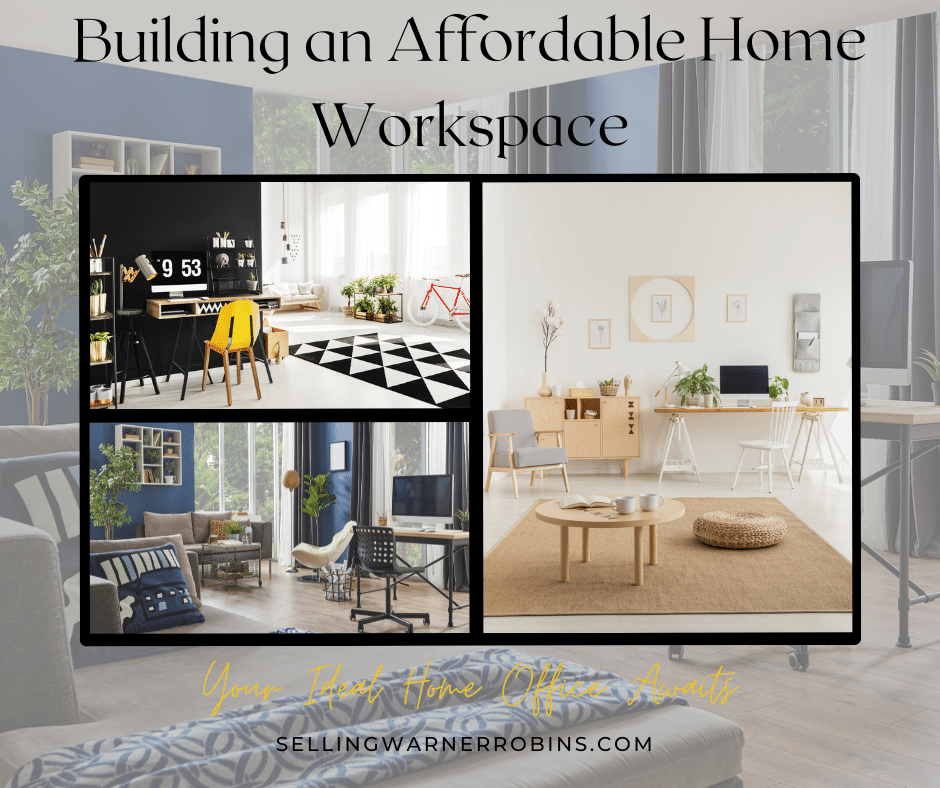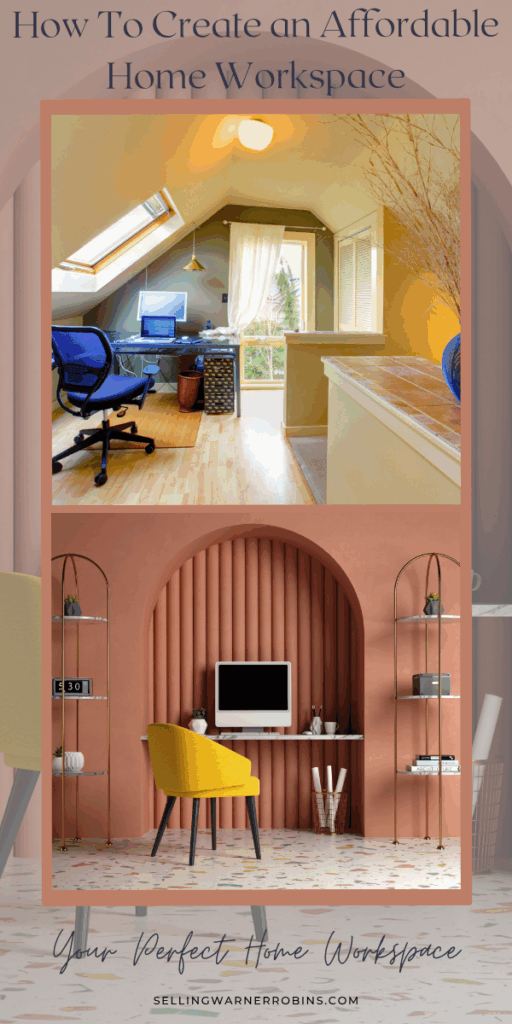Simple Guide to Building an Affordable Home Workspace
Have you dreamed of building an affordable home workspace but did not have a dedicated spot and you worried about the cost? Creating a functional and comfortable home office doesn’t have to break the bank when approaching it strategically.
By focusing on essential items first and choosing innovative alternatives like gently used furniture or refurbished equipment, you can build a productive workspace that meets your needs while staying within budget.
Let’s explore practical ways to create your ideal home office through thoughtful planning, creative space utilization, and budget-conscious decisions that will help you work efficiently without overspending. Building an affordable home workspace has never been easier…check out the details and see if you are up to the challenge.

Prioritizing Essential Purchases
Setting up a home office doesn’t have to drain your bank account. By focusing on core essentials first, you’ll create a functional workspace that meets your needs while staying within budget.
A thoughtful approach to purchasing office items helps you avoid spending too much on unnecessary extras. Start with the basics that directly impact your work efficiency and physical comfort.
The right chair and desk should be at the top of your list since you’ll use them daily. To guide your initial purchases, here are the essential items to focus on:
- Begin with an ergonomic chair that supports good posture
- Choose a sturdy desk that fits your space and work style
- Invest in proper lighting to reduce eye strain
- Add storage solutions to keep your workspace organized
- Consider second-hand options for non-essential items
Remember that setting up your home office is an ongoing process. You don’t need to buy everything at once.
Wise shopping choices, such as buying gently used furniture or reliable refurbished desktop computers, can help you save significantly without compromising quality.
Start with the fundamental pieces that help you work effectively, then add more items as your budget allows. Many people find that a minimalist approach helps them stay more focused and productive.
Creative Space Selection
You don’t need a dedicated room to create an effective home office. Even a small, unused nook in your home can transform into a productive workspace.
Look around your living area – that empty corner in your bedroom, the space under your stairs, or even a portion of your dining room could become your new office spot without spending much money.
Here are innovative ways to make the most of your chosen space:
- Place a slim desk against an empty wall to create an instant work area
- Use room dividers or bookcases to separate your office from living spaces
- Convert an unused closet by removing the doors and adding a desk
- Install floating shelves above your desk for extra storage
- Consider a folding desk that can be tucked away after work hours
The key to success lies in choosing multifunctional furniture that serves dual purposes. A storage ottoman can double as extra seating for clients, while a console table might work as a desk and entryway piece.
Use vertical space effectively – wall-mounted organizers and pegboards can keep your supplies organized without wasting precious floor space.
Remember, with creative thinking, even the smallest area can become a functional home office that helps maintain a healthy work-life balance.
| Reimagined wasted spaces: Walk through your entire home with fresh eyes and identify overlooked zones—hallway ends, loft areas, or wide window sills—that could be optimized with simple additions like a stool or tray table for an instant mini-office. |
Optimizing Layout for Productivity
A well-organized workspace can significantly improve your daily work routine. Setting up your desk with ergonomics in mind helps prevent physical strain and boosts your focus throughout the day.
Properly positioning equipment, especially your monitor, at eye level reduces neck strain and creates a more comfortable working environment.
Creating a clutter-free workspace doesn’t have to be expensive. An innovative organization helps maintain efficiency and mental clarity while you work. It’s incredible how much better you’ll feel when everything has its place.
To help you create an efficient and comfortable home office, consider these layout and organization tips:
- Use mason jars or recycled containers to sort small office supplies
- Install floating shelves for vertical storage to maximize desk space
- Bundle cables with velcro straps or binder clips for neat cable management
- Repurpose shoe boxes or cereal boxes as drawer organizers
- Add a monitor stand using sturdy books or a wooden plank
You can transform your desk into an efficient command center with minimal investment. Simple solutions like using binder clips to prevent charging cables from falling off your desk or adding a cardboard box under your desk for cable management work wonders.
These minor organizational tweaks can lead to significant improvements in your daily workflow.
Lighting Solutions on a Budget
Wise home lighting choices can transform your workspace without straining your wallet. Natural light is the perfect cost-free option that brightens your home office while lifting your spirits.
Placing your desk near a window saves on electricity, helps maintain your body’s natural rhythm, and keeps you alert during work hours.
To make the most of natural light and supplement it efficiently, here are some practical tips:
- Position your desk at a 90-degree angle to windows to reduce glare on your screen
- Use light-colored curtains or sheer blinds to filter harsh sunlight
- Keep windows clean to maximize natural light penetration
- Consider using mirrors to reflect and amplify available daylight
- Arrange your workspace to avoid shadows falling on your work area
For those darker hours or cloudy days, energy-efficient LED bulbs offer an affordable lighting solution that pays for itself through reduced electricity costs. You’ll find budget-friendly desk lamps at discount stores that provide focused task lighting exactly where you need it.
Consider using warm-toned bulbs in your workspace. They’re easier on your eyes during long work sessions and create a cozy atmosphere that helps you stay focused.
Remember to position your artificial light sources to minimize screen reflections and eye strain while maintaining consistent illumination throughout your workday.
| Smart lighting solutions: Thoughtful lighting is more than aesthetic—it supports mental clarity, reduces fatigue, and enhances productivity, all without demanding a significant investment. |
Personalizing the Workspace
Your home office should reflect your unique style without draining your wallet. Adding personal touches can transform a basic workspace into an inspiring environment that fuels creativity and motivation.
Simple DIY projects and thoughtful decorations can significantly affect your feelings while working from home. Here are some creative and budget-friendly ways to personalize your home office:
- Create a gallery wall using family photos in thrifted frames
- Design custom wall art using materials you already have
- Repurpose old containers into stylish pen holders and organizers
- Paint existing furniture pieces to match your preferred color scheme
- Make your bulletin board from cork and fabric scraps
Indoor plants can breathe life into your workspace while serving practical purposes. They’re not just beautiful – they help clean the air and boost your mood during long work hours.
Choose low-maintenance options like snake plants that thrive in various light conditions and don’t need frequent watering.
The key to budget-friendly personalization lies in being resourceful with what you have. Scout local thrift stores for unique decor pieces or transform ordinary items into eye-catching accessories.
Even simple touches like arranging your favorite books on a shelf or displaying meaningful trinkets can create a workspace that feels uniquely yours without spending much money.
Harnessing Technology Without Overspending
Setting up a tech-savvy home office doesn’t mean emptying your wallet. Wise choices and resourceful planning can help you create an efficient workspace while keeping costs in check. 
Your existing devices likely have untapped potential that you can maximize before considering new purchases.
Making the most of affordable technology starts with exploring free and low-cost alternatives to premium software. Many budget-friendly options offer similar features to their expensive counterparts.
Looking for reliable computing solutions? Refurbished desktops can provide excellent value while helping you stay within budget.
Here are some practical ways to manage your technology needs without overspending:
- Use free cloud storage services like Google Drive or Dropbox for file management
- Try open-source alternatives to paid software, such as LibreOffice for document processing
- Take advantage of free video conferencing tools like Zoom’s basic plan
- Leverage built-in computer features instead of purchasing additional software
- Consider browser-based tools that don’t require installation or subscriptions
Remember to assess your current devices’ capabilities before rushing to upgrade. A simple memory upgrade or software update can often revive your existing equipment.
Focus on maintaining your essential tools properly to extend their lifespan and postpone the need for replacements.
Managing Ongoing Expenses
Running a home office doesn’t have to drain your wallet. By making wise choices about your equipment and daily habits, you can keep those recurring costs under control.
Opt for energy-efficient devices that won’t need frequent repairs or replacements. Focus on long-lasting products that cost a bit more upfront but save money through reduced maintenance needs. Here are a few tips to effectively manage your home office’s ongoing expenses:
- Choose LED bulbs and Energy Star-certified electronics to reduce electricity bills
- Set up automated power strips to prevent phantom energy drain
- Switch to cloud storage instead of external hard drives that can fail
- Use refillable ink cartridges instead of disposable ones
- Install a smart thermostat to regulate office temperature efficiently
- Go paperless with digital document signing and storage options
Your daily habits can make a huge difference in keeping costs down. Creating digital workflows eliminates the need for paper and ink while making document management easier.
Remember to unplug devices or use a power strip’s off switch when you’re done working—those small actions add up to noticeable savings on your utility bills. Switching off equipment during lunch breaks and after hours helps extend its lifespan, too.
Common Mistakes to Avoid When Setting Up a Budget Workspace
Setting up a budget workspace is critical for businesses and individuals aiming to manage finances effectively. However, several common mistakes can undermine the success of this process.
Avoiding these pitfalls ensures that your budget workspace is both practical and efficient.
Not Setting Realistic Goals
One of the most frequent errors is establishing unrealistic financial goals. Ambitious targets may seem motivating, but if they are unattainable based on past financial performance or current economic conditions, they can lead to frustration and poor budgeting outcomes.
Set goals grounded in actual data and industry standards to maintain achievable expectations.
Underestimating or Overestimating Expenses
Accurate expense forecasting is essential. Many make the mistake of not thoroughly reviewing past expenses, leading to either underfunding or overspending.
Detailed analysis of previous financial records and categorizing expenses by priority helps allocate funds appropriately and avoid budget discrepancies.
Ignoring Unexpected or One-Time Costs
Unexpected expenses, such as emergency repairs or sudden operational costs, can disrupt budgets if not anticipated. Including a contingency or emergency fund within your budget workspace safeguards against these surprises and maintains financial stability.
Impulsive or Unplanned Purchases
Impulse buying or failing to compare prices and features before purchasing can quickly derail a budget. Planning purchases carefully, researching options, and avoiding unnecessary extended warranties or add-ons help keep spending within limits.
Setting up a budget workspace requires careful planning, realistic goal-setting, and ongoing management. This foundation supports better decision-making, financial stability, and ultimately, business success.
Expanding Gradually Over Time
Building your home office in stages helps you manage costs while creating a space that matches your growing needs. Instead of rushing to buy everything at once, a thoughtful approach to expanding your workspace lets you make smarter purchasing decisions.
Think of your home office as an evolving project that adapts to your changing work requirements.
Your workspace efficiency will improve as you discover which tools and accessories boost your productivity.
For example, you might realize that a second monitor significantly speeds up your workflow, or that a proper filing system would save you valuable time. Taking a step-by-step approach also allows you to test different layouts and configurations simultaneously without committing to expensive changes.
Remember that comfort and functionality should guide your expansion choices. Each addition to your office should serve a clear purpose and fit within your budget constraints. This mindful strategy ensures that every dollar spent contributes meaningfully to your work environment.
Your Productive Space, Your Way
Creating a functional home office on a budget is an achievable goal that requires strategic planning and resourceful thinking. Through innovative prioritization of essential items, creative space utilization, and gradual expansion over time, you can build a productive workspace without breaking the bank.
Remember that a well-designed home office isn’t about having the most expensive equipment or the latest gadgets—it’s about creating a space that supports your work style and enhances your productivity.
Let your workspace evolve naturally as you discover what truly matters for your success.
If you found this article on building an affordable home workspace helpful, please share the article so more consumers can benefit from the information provided.
Guide to Building an Affordable Home Workspace
About Anita Clark Realtor
Anita Clark has written 687 posts on this blog.
by Anita Clark Anita is a residential Real Estate Agent in Warner Robins Georgia, with Coldwell Banker Access Realty (478) 953-8595, aiding buyers and sellers with all their real estate questions on her Warner Robins blog.



